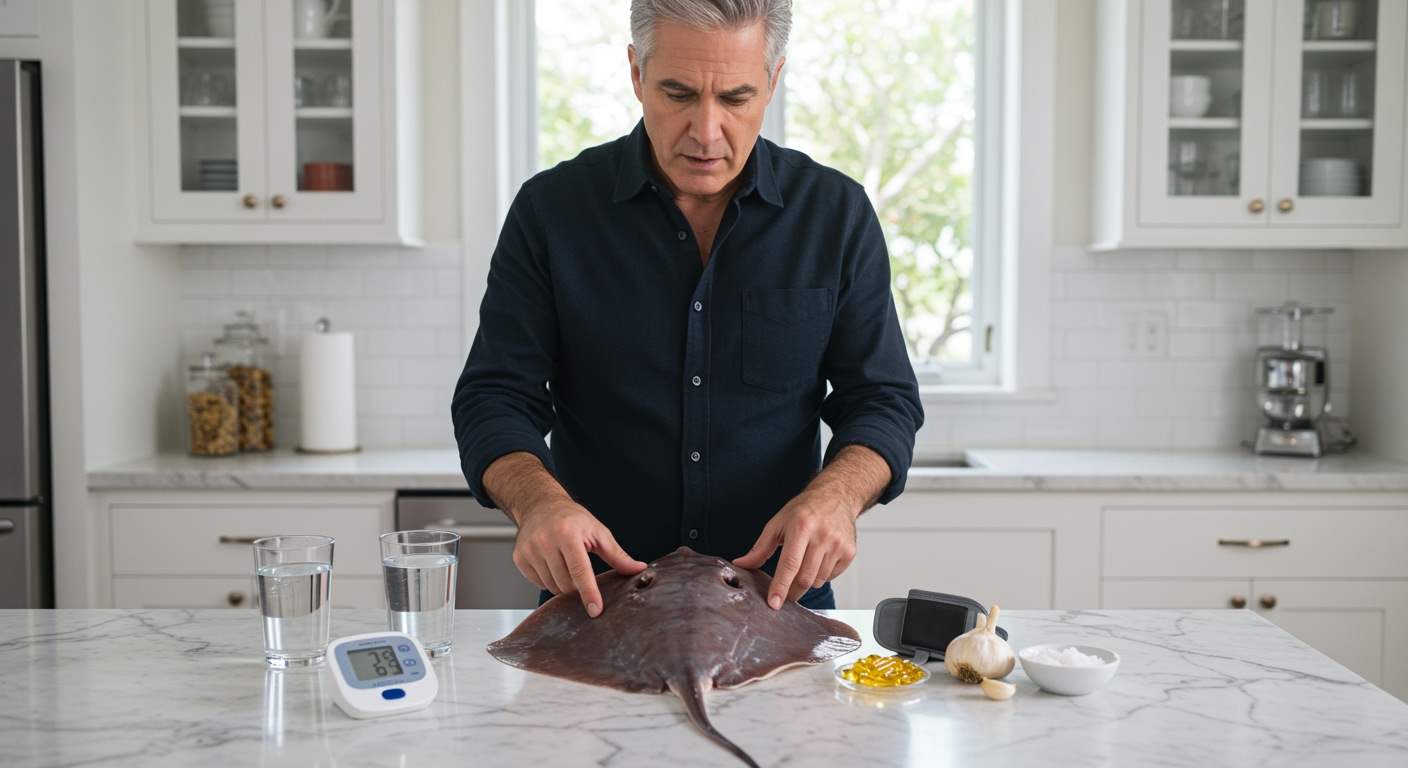✪ Key Takeaway: Ray fish does not directly raise blood pressure and may actually help lower it due to omega-3 fatty acids and potassium content.
Introduction
You walk through the seafood section and spot ray fish on display.
Your mind immediately wonders about its effects on blood pressure because you have been managing low blood pressure or trying to avoid high blood pressure.
Hi, I’m Abdur, your nutrition coach and today I’m going to explain exactly how ray fish affects your blood pressure and what you need to know before adding it to your diet.
What Makes Ray Fish Different From Other Seafood?
Ray fish belongs to the cartilaginous fish family, which means it has a skeleton made of cartilage instead of bone.
This unique structure affects its nutritional composition compared to regular bony fish.
Ray fish contains high levels of potassium, which is a mineral that helps regulate blood pressure by counteracting sodium effects.
The flesh of ray fish also provides omega-3 fatty acids, particularly EPA and DHA, which support cardiovascular health.
Unlike some other seafood, ray fish has moderate sodium content, making it suitable for people watching their salt intake.
The protein content in ray fish is complete, meaning it contains all essential amino acids your body needs for proper function.
✪ Fact: Ray fish contains about 380mg of potassium per 100g serving, which helps maintain healthy blood pressure levels.
How Does Ray Fish Actually Affect Blood Pressure?
The potassium content in ray fish works as a natural blood pressure regulator by helping your kidneys remove excess sodium.
When you consume potassium-rich foods like ray fish, your blood vessels relax and widen, which reduces pressure on arterial walls.
The omega-3 fatty acids in ray fish help reduce inflammation in blood vessels and improve their flexibility.
These healthy fats also support the production of nitric oxide, a compound that helps blood vessels dilate naturally.
Ray fish provides magnesium, another mineral that works alongside potassium to maintain proper blood pressure levels.
The lean protein in ray fish does not contain compounds that would cause blood pressure spikes like some processed meats do.
✪ Pro Tip: Prepare ray fish with herbs and spices instead of salt to maximize its blood pressure benefits.
What About Mercury and Other Concerns?
Ray fish typically contains lower mercury levels compared to large predatory fish like shark or swordfish.
However, the mercury content can vary depending on where the ray fish was caught and its size.
Mercury does not directly raise blood pressure, but high levels can affect kidney function, which indirectly impacts blood pressure regulation.
The preparation method matters more than the fish itself when it comes to blood pressure effects.
Frying ray fish in oil and adding salt will counteract its natural blood pressure benefits.
Grilling, baking, or steaming ray fish preserves its beneficial nutrients while avoiding added sodium and unhealthy fats.
✪ Note: Choose ray fish from reputable sources and limit consumption to 2-3 servings per week for optimal health benefits.
Should You Include Ray Fish in Your Diet?
Ray fish can be a beneficial addition to your diet if you are managing blood pressure concerns.
The combination of potassium, omega-3s, and lean protein makes it a heart-healthy choice when prepared properly.
People with low blood pressure should not worry about ray fish causing further drops in their readings.
Those with high blood pressure may find ray fish helpful as part of a comprehensive dietary approach to managing their condition.
Always consult with your healthcare provider before making significant dietary changes, especially if you take blood pressure medications.
Ray fish works best when combined with other heart-healthy foods like vegetables, whole grains, and fruits.
✪ Pro Tip: Pair ray fish with potassium-rich vegetables like spinach or sweet potatoes for maximum blood pressure benefits.
The Bottom Line
Ray fish does not raise blood pressure and may actually help lower it through its potassium and omega-3 content.
The way you prepare your food matters more than the food itself when it comes to blood pressure management.
I would love to hear about your experiences with ray fish or any questions you have about seafood and blood pressure in the comment section below.
References
At NutritionCrown, we use quality and credible sources to ensure our content is accurate and trustworthy. Below are the sources referenced in creating this article:
- British Heart Foundation: Fish oils and blood pressure powers
- Healthline: Fish Oil Side Effects
- PMC: Omega-3 fatty acids and cardiovascular disease
- Vocal Media: Benefits of eating stingray





